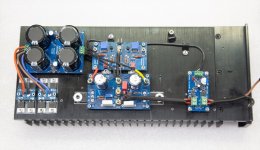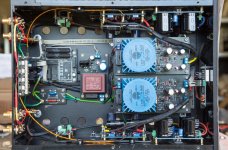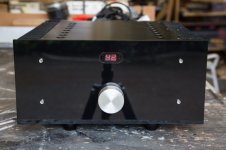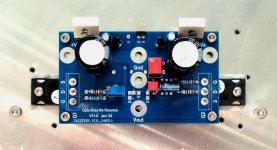Hi all,
Group buy details as mentioned above are posted over in the GB section:
https://www.diyaudio.com/community/threads/f5pi-gb-for-us-mosfets-bom-etc.409406/
Fran
Group buy details as mentioned above are posted over in the GB section:
https://www.diyaudio.com/community/threads/f5pi-gb-for-us-mosfets-bom-etc.409406/
Fran
For those interested in duplicating our prototype, sorry to keep you waiting :
https://www.diyaudio.com/community/...shiba-q-set-for-the-f5pi.410439/#post-7630849
https://www.diyaudio.com/community/...nal-pcb-set-for-the-f5pi.410440/#post-7630856
Thank you for your interest,
Patrick
https://www.diyaudio.com/community/...shiba-q-set-for-the-f5pi.410439/#post-7630849
https://www.diyaudio.com/community/...nal-pcb-set-for-the-f5pi.410440/#post-7630856
Thank you for your interest,
Patrick
This weekend, I have substantially finished the build of an F5Pi using USA mosfets as provided in the recent group buy, while varying a little from the current group buys for F5Pi PCBs.
I used the relaixed system from Jos von Eijndhoven for source selection and attenuation, along with separate supplies for front end and output stage. The chassis is made from sheet alu cut to make the individual panels, as I had some damaged heatsinks of the appropriate size, I pressed those into service rather than see them go to waste. The front panel is 8mm black acrylic.
I mounted most of the "amplifier" parts on each heatsink - output stage power supplies, front end and power boards, and the speaker protection keeping cable runs as short as possible. It also helps with thermal management for the regulated output stage supply. The floor of the amplifier then has the aux power supply, relaixed soft start module, an earthing circuit breaker, transformer (hidden under the platform with front end supplies) and the front end supplies themselves (the ones with the blue talema transformers). The source select and attenuator board is mounted on the rear panel to keep lines as short as possible.
The amplifier both measures well, handles reactive loads well, and sounds great. For those who might be planning a build using the group buy boards, you will find there is a significant amount of work in the build, but you will be very well rewarded at the end. I would also say my work was increased because of the extra metalwork.
Modules mounted on the heatsink:

Internal view of the completed amp. Transformer is under the platform at the front of the chassis under the smaller front end transformers.

Finished front view - excuse the tripod showing the photo, its hard to avoid reflections in what is really a mirror!

I used the relaixed system from Jos von Eijndhoven for source selection and attenuation, along with separate supplies for front end and output stage. The chassis is made from sheet alu cut to make the individual panels, as I had some damaged heatsinks of the appropriate size, I pressed those into service rather than see them go to waste. The front panel is 8mm black acrylic.
I mounted most of the "amplifier" parts on each heatsink - output stage power supplies, front end and power boards, and the speaker protection keeping cable runs as short as possible. It also helps with thermal management for the regulated output stage supply. The floor of the amplifier then has the aux power supply, relaixed soft start module, an earthing circuit breaker, transformer (hidden under the platform with front end supplies) and the front end supplies themselves (the ones with the blue talema transformers). The source select and attenuator board is mounted on the rear panel to keep lines as short as possible.
The amplifier both measures well, handles reactive loads well, and sounds great. For those who might be planning a build using the group buy boards, you will find there is a significant amount of work in the build, but you will be very well rewarded at the end. I would also say my work was increased because of the extra metalwork.
Modules mounted on the heatsink:

Internal view of the completed amp. Transformer is under the platform at the front of the chassis under the smaller front end transformers.

Finished front view - excuse the tripod showing the photo, its hard to avoid reflections in what is really a mirror!

F5Pi builders will notice that this is compatible with the F5 Frontend.
https://www.diyaudio.com/community/threads/the-holy-grail-follower-output-stage.406850/post-7671867
At least in simulations, it doesn't improve things for the Toshiba M2OPS.
So I would not hold back the build because of this.
For the other MOSFET pairings, it does seem to lower distortion of the OPS itself.
Whether it does when combined with the frontend remains to be seen.
But it works, and is not too complicated.
Once we have finished all measurements, we shall publish.
Will take time.
Patrick
.
https://www.diyaudio.com/community/threads/the-holy-grail-follower-output-stage.406850/post-7671867
At least in simulations, it doesn't improve things for the Toshiba M2OPS.
So I would not hold back the build because of this.
For the other MOSFET pairings, it does seem to lower distortion of the OPS itself.
Whether it does when combined with the frontend remains to be seen.
But it works, and is not too complicated.
Once we have finished all measurements, we shall publish.
Will take time.
Patrick
.
Attachments
Apologies if there's a better place to ask this.
Build notes recommend an analogue signal generator. Most are dac-based, however @EUVL post #88
What are the options for analogue signal generators? - specific models would be helpful as I'll be searching eBay etc.
Tia
Build notes recommend an analogue signal generator. Most are dac-based, however @EUVL post #88
ringing comes from the digital signal generator, probably cable reflections interacting with its output stage.
...
Replace the digital signal generator with an analogue one, and 100kHz square wave was absolutely smooth.
What are the options for analogue signal generators? - specific models would be helpful as I'll be searching eBay etc.
Tia
If you are only testing with sine or triangular waves, you can also use digital signal generators.
It is only when you test with square wave that it becomes picky.
We have an old analogue signal generator in the lab.
That is what we used.
Since we already tested multiple examples, we know the circuit is stable.
But if you do want to test yourself, I guess you are looking for something low cost.
I can only suggest you take a look at ICL8038 or XR2206 based solutions.
But you need to make sure the output is AC coupled and suitably buffered, such that the output impedance is not more than 600 ohm.
Patrick
It is only when you test with square wave that it becomes picky.
We have an old analogue signal generator in the lab.
That is what we used.
Since we already tested multiple examples, we know the circuit is stable.
But if you do want to test yourself, I guess you are looking for something low cost.
I can only suggest you take a look at ICL8038 or XR2206 based solutions.
But you need to make sure the output is AC coupled and suitably buffered, such that the output impedance is not more than 600 ohm.
Patrick
Earlier at another thread, we posted an experimental output stage based loosely on the M2OPS, but without R_source.
https://www.diyaudio.com/community/threads/the-holy-grail-follower-output-stage.406850/post-7671867

This is a modified version of :
https://www.diyaudio.com/community/threads/the-holy-grail-follower-output-stage.406850/post-7544067
with 10,000µF caps added between the MOSFET drains and Gnd.
Also the current sensing resistors are changed to 1R 5W (MPC74), and additional diodes (1N4148) between the rails and the BJT emitters.
This will then result in 1.2A bias, and the 1R_10,000µF will give a LP corner frequency of ~16Hz.
Distortion measurements have been done using unmatched pairs of the following MOSFET combinations :
Vishay IRFP240/9240
Fairchild FQA10N80C/9P25
Fairchild FQA28N15/36P15
The results are as follows :
MOSFET__ H2______H3
IRFP_______-73_____-103
FQ1009___-71_____-103
FQ2836___-71_____-99
One can compare this to earlier results on the (standard) M2OPS measured by Twitchie :
https://www.diyaudio.com/community/threads/complementary-power-mosfets.378024/post-6888301
https://www.diyaudio.com/community/threads/complementary-power-mosfets.378024/post-6889027
MOSFET__ H2______H3
IRFP_______-82_____-88
FQ1009___-80_____-89
FQ2836___-71_____-91
One can see a noticeable improvement in H3, as expected when not using source degeneration.
Output impedance (Zout) is around 0.2R for all 3 pairings, also lower than with source degeneration, as expected.
As mentioned before, one can reduce H2 by trimming with the aid of a distortion analyser, at the expense of slight increase in Zout :
https://www.diyaudio.com/community/threads/the-holy-grail-follower-output-stage.406850/post-7656574
In both cases, the -3dB bandwidth is beyond 2MHz.
Credit to Fran for performing all the measurements. 🙏🙏
Patrick
https://www.diyaudio.com/community/threads/the-holy-grail-follower-output-stage.406850/post-7671867
This is a modified version of :
https://www.diyaudio.com/community/threads/the-holy-grail-follower-output-stage.406850/post-7544067
with 10,000µF caps added between the MOSFET drains and Gnd.
Also the current sensing resistors are changed to 1R 5W (MPC74), and additional diodes (1N4148) between the rails and the BJT emitters.
This will then result in 1.2A bias, and the 1R_10,000µF will give a LP corner frequency of ~16Hz.
Distortion measurements have been done using unmatched pairs of the following MOSFET combinations :
Vishay IRFP240/9240
Fairchild FQA10N80C/9P25
Fairchild FQA28N15/36P15
The results are as follows :
MOSFET__ H2______H3
IRFP_______-73_____-103
FQ1009___-71_____-103
FQ2836___-71_____-99
One can compare this to earlier results on the (standard) M2OPS measured by Twitchie :
https://www.diyaudio.com/community/threads/complementary-power-mosfets.378024/post-6888301
https://www.diyaudio.com/community/threads/complementary-power-mosfets.378024/post-6889027
MOSFET__ H2______H3
IRFP_______-82_____-88
FQ1009___-80_____-89
FQ2836___-71_____-91
One can see a noticeable improvement in H3, as expected when not using source degeneration.
Output impedance (Zout) is around 0.2R for all 3 pairings, also lower than with source degeneration, as expected.
As mentioned before, one can reduce H2 by trimming with the aid of a distortion analyser, at the expense of slight increase in Zout :
https://www.diyaudio.com/community/threads/the-holy-grail-follower-output-stage.406850/post-7656574
In both cases, the -3dB bandwidth is beyond 2MHz.
Credit to Fran for performing all the measurements. 🙏🙏
Patrick
Attachments
Last edited:
'This will then result in 1.2A bias, and the 1R_10,000µF will give a LP corner frequency of ~16Hz'
Can I ask why this is necessary? In a class A/B application I can see the need for a low ESR local power decoupling cap, but why is a LP filter needed at 16Hz?
Are you just making absolutely sure that there's no audio Freq noise on the power rails?
Can I ask why this is necessary? In a class A/B application I can see the need for a low ESR local power decoupling cap, but why is a LP filter needed at 16Hz?
Are you just making absolutely sure that there's no audio Freq noise on the power rails?
Actually in this particular case, you really only need an analogue square wave generator, say around 1kHz, to look for any ringing.But if you do want to test yourself, I guess you are looking for something low cost.
I can only suggest you take a look at ICL8038 or XR2206 based solutions.
Elliott has one (near the bottom of the page), with all details how to build.
https://sound-au.com/articles/squarewave.htm
And 9V battery supply is more than plenty.
You are more likely to need output <2Vpp.
Patrick
Attachments
- Home
- Amplifiers
- Pass Labs
- The F5Pi -- F5P Voltage Gain Stage + M2 Output Stage = Perfectly Integrated


